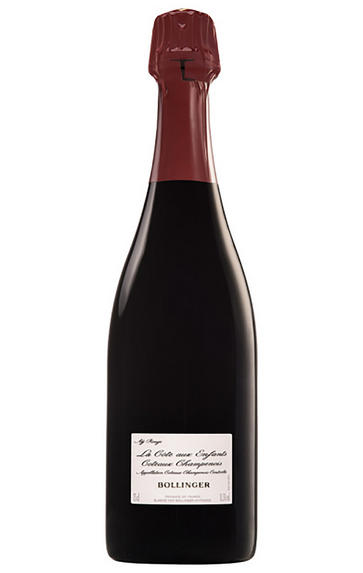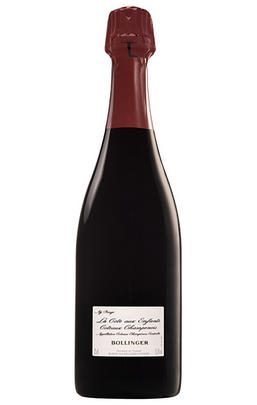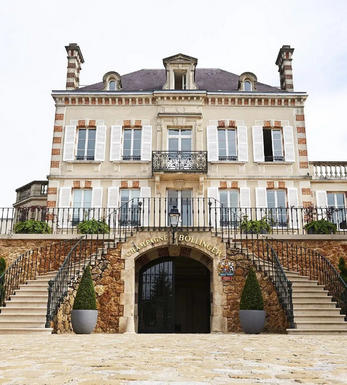
2016 Coteaux Champenois Rouge, La Côte aux Enfants, Bollinger, Champagne

About this WINE

Bollinger
The Champagne House of Bollinger was established in 1829 by Jacques Bollinger and Paul Renaudin. Over the years the vineyard holdings have been steadily increased with the largest expansion taking place under the stewardship of the legendary Mme Lily Bollinger. She ran the company between 1941 and 1977 and today it is managed by her great-nephew, Ghislain de Montgolfier.
Bollinger has a reputation for producing muscular champagnes with body, depth and power, and is today considered one of the "Great" Champagne houses.
70% of the grapes come from the firm's own vineyards. 80% of the harvest is barrel-fermented with the wines being kept on their yeast lees for an extended period of time (in the case of the RD, around 10 years).
Bollinger produces classic, complex, Pinot-Noir dominated champagnes with the ability to age gracefully for many years.

Brut Champagne
Brut denotes a dry style of Champagne (less than 15 grams per litre). Most Champagne is non-vintage, produced from a blend from different years. The non-vintage blend is always based predominately on wines made from the current harvest, enriched with aged wines (their proportion and age varies by brand) from earlier harvests, which impart an additional level of complexity to the end wine. Champagnes from a single vintage are labelled with the year reference and with the description Millésimé.
Non-vintage Champagnes can improve with short-term ageing (typically two to three years), while vintages can develop over much longer periods (five to 30 years). The most exquisite and often top-priced expression of a house’s style is referred to as Prestige Cuvée. Famous examples include Louis Roederer's Cristal, Moët & Chandon's Dom Pérignon, and Pol Roger's Cuvée Sir Winston Churchill.
Recommended Producers : Krug, Billecart Salmon, Pol Roger, Bollinger, Salon, Gosset, Pierre Péters, Ruinart

Pinot Noir
Pinot Noir is probably the most frustrating, and at times infuriating, wine grape in the world. However when it is successful, it can produce some of the most sublime wines known to man. This thin-skinned grape which grows in small, tight bunches performs well on well-drained, deepish limestone based subsoils as are found on Burgundy's Côte d'Or.
Pinot Noir is more susceptible than other varieties to over cropping - concentration and varietal character disappear rapidly if yields are excessive and yields as little as 25hl/ha are the norm for some climats of the Côte d`Or.
Because of the thinness of the skins, Pinot Noir wines are lighter in colour, body and tannins. However the best wines have grip, complexity and an intensity of fruit seldom found in wine from other grapes. Young Pinot Noir can smell almost sweet, redolent with freshly crushed raspberries, cherries and redcurrants. When mature, the best wines develop a sensuous, silky mouth feel with the fruit flavours deepening and gamey "sous-bois" nuances emerging.
The best examples are still found in Burgundy, although Pinot Noir`s key role in Champagne should not be forgotten. It is grown throughout the world with notable success in the Carneros and Russian River Valley districts of California, and the Martinborough and Central Otago regions of New Zealand.


Buying options
Add to wishlist
Description
Long before we found bubbles in our Champagne, this region was praised for producing excellent red wines. Bollinger’s La Côte aux Enfants cuvée takes us back to these days gone by, but with modern viticulture. It’s produced from a steep sided Grand Cru plot of just four-hectares, named “La Côte aux Enfants” in the village of Aÿ. It can be described as a tiny production, hauntingly perfumed 100% Pinot Noir with real elegance and good cellaring potential. It’s a brilliant testament to the true beginnings of Champagne’s success, fame and fortune.
This very special Pinot Noir greets you with aromas of black rose petals and damson, the nose unfolding with an enticing spiciness and muddled forest fruit. Seamlessly balanced, the palate offers up a crunchy core of wild red fruit, flickers of bramble enveloped with subtle spice, framed by a graphite acidity. Ooh this is tasty, it doesn’t stop there though; the texture is mouth-filling, tannins are perfectly aligned - ripe with a gentle grip, and it moves through the gears towards a long and graceful finish. Whole bunch pressing brings another dimension, carrying the depth of flavour yet retaining freshness and poise, its rather impressive. Sadly, production is miniscule, a wine for Pinot Noir drinkers and collectors alike, it is unlikely to hang around for long, grab a case whilst you can. I’d afford it at least few years in the cellar, it will reward drinking from 2023 – 2034, or hitting the sweet spot from 2028 if you have the patience!
wine at a glance
Delivery and quality guarantee